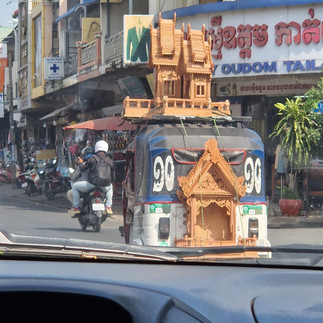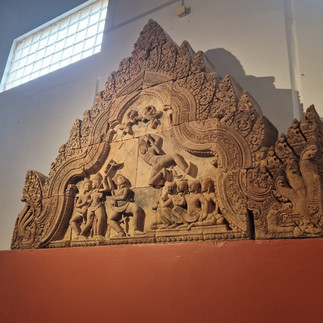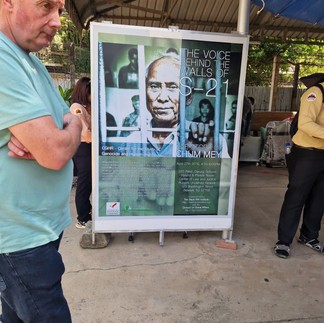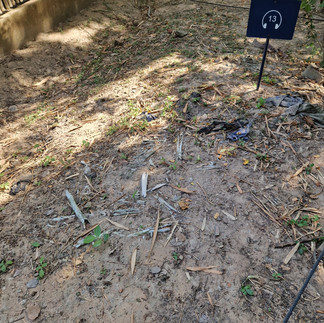
Big Trip 2024 Cambodia Part 1
- Anne B 10milesfrom

- Jan 19, 2024
- 9 min read
Welcome to everyone, and especially all our new subscribers! I just wanted to Thank you for signing up and also to explain that I write these blogs as our own diary of our trips, and I use the blog to share it with anyone else who might be interested, or who might get some useful ideas from it! This blog todays is a bit unusual. It has a pretty long section about events in Cambodias recent history at the end which I am including because it was important to us to write it and include it, but it is not pleasant. I have clearly indicated where it starts, so it is at your discretion whether to read it!
Ok, on with the trip! From refined, peaceful and super-efficient Changhi airport we flew to Phnom Penh, the capital of Cambodia, a country on our bucket list for a long time. It is a rapidly developing city, with modern skyscrapers and housing sprouting everywhere, mainly financed by China, South Korea and Vietnam. They encircle the more traditional old town, and our hotel, the Penh house, was in the heart of the main sights. It was a lovely oasis of calm with a beautiful rooftop pool (I even had a swim!), and restaurant. Even better it was within walking distance, or a US$ 2-3 tuk tuk ride of most of the main sights.
The language spoken is Khmer, and its written form is exquisite! Some people speak a little English, and a few speak French. Currency is the Riel, but the US$ is accepted in most places. Bring lots of smaller denominations for tipping etc.
Cambodia is one of the poorest countries in Asia, and in the last 50 years it has been to hell and back, which you will read about later. Their main revenue comes from Tourism, garment export and agriculture, and like most countries, they were hit hard in the Covid Pandemic. It is no surprise that everyone is trying to win your custom to make a few extra dollars. The average salary of a hotel worker is about £130 per month! Tipping is not essential but it really helps! It took us just a few hours to fall in love with Phnom Penh and its people..... and Cambodian food!!
We arrived mid afternoon, so just went walking around the old city, through one of the many markets to the waterfront, the shores of the mighty Mekong. Cambodia was a French territory from 1863 until 1953. The influence still remains in some of the French colonial architecture, the cuisine and the love of promenading along the waterfront in the evening, past many street food sellers. Our dinner was at the hotel. The view was wonderful, and the Cheshire cat moon reminded us that we were in a very different part of the world than home, as we never see it at that angle in England!
Walking outside, first impressions are that Phnom Penh is noisy and chaotic, there is lots of litter, and tuk tuk drivers frequently stop to persuade you to ride rather than walk. But this city grows on you! Everybody is so friendly, and when you earn a smile, it lights up their whole face. We got used to traffic driving both ways on both sides of the road, 12 year olds 3 up on a motorbike, a mum breastfeeding her baby while riding pillion, and saffron robed monks everywhere!
We strolled through a market where most goods were on leaves or trays on the floor, including eggs, meat and fish!
Hammocks are everywhere. Under articulated lorries, hanging over the goods in the market or just looped between fence posts in case a snooze is called for.
During our stay here we visited the Incredibly ornate Royal Palace where the King and his family still live, so some parts were closed or under repair. The Royal family have been in existence since AD 68, apart from their abolition between 1970 and 1993. The most impressive sights include the throne room (no photos allowed) and the vast walkway and frieze painted in 1903-1907 which depicts good vs evil In the tale of Reamker, a 7th century epic Cambodian poem.
The Silver Pagoda has a floor of silver tiles, and houses the Emerald Buddha, thought to have been made by Lalique, and an almost life-size Buddha encrusted with 2000 diamonds. The room of the Buddhas handprints is a sacred sanctuary, as are the buildings housing a 16th century sacred cow of Shiva.
The ornate towers are called stupas, and are the shrines of former members of the Royal family. You see these all over the country and even in people's gardens in a simpler form. A final few museum rooms of artefacts and ceremonial items also revealed that the servants wore different colour clothes for each day of the week, and displayed an impressive collection of regal transport including elephant Howdahs. And of course the famous cat elephant, a much revered figure!
The National museum contains many of the historical artefacts found at Angkor and other sites. Many are over 1000 years old, and are of Hindu gods, Buddha statues and ancient inscriptions engraved onto stone.
We also visited Wat Botum and Pagoda, the oldest in Phnom Penh dating back to 1442. It is part of a huge Buddhist monastery, beautiful inside and almost next to our hotel!
Southern Cambodia seems very, very flat! The southern part is on part of the vast River Mekong floodplain. Wat Phnom, another shrine, is the most revered and sits on top of an artificial hill created in 1372 by Lady Penh to elevate it above everything else! We visited on Sunday and the area was teeming with Cambodians of all ages praying, and making donations of flowers, money and food. Just next to the shrine is a meeting room. A big event was being held which seemed to consist of everyone selecting food from meats and other provisions on laden tables, then queuing to have yourself and the plate blessed! We asked various local people (with the invaluable help of Google translate) what was the occasion, and none of them had a clue! The other surprise in the park were the large Hornbills roosting in the trees. Incredible to see.
We learned that Cambodia produces the Kampot peppercorn, supposedly the tastiest in the world, and that Cambodian food is delicious. Most is not hot and spicy like neighbouring Thailand, but subtle, using ginger, lemongrass and coconut a great deal. Chris discovered Cambodia and Angkor beer and helped their profits! We were sad to leave Phnom Penh but a bargain journey on the Cambodian Post Bus was to take us North to Kampon Thom. 168 kms for £8 each. And it turned out to be the VIP post bus! The driver was fast, overtook almost everything on the road, and yet we felt remarkably safe! A great way to travel! New adventures await!
Now here is the part that is definitely not pleasant. As our guide said: "This is not a happy tour, this a heartbreak tour". You have been warned.
It seemed wrong to visit Cambodia without trying to understand it's traumatic past. The next part of the blog will not make pleasant reading. I had arranged a trip to see the Killing fields, and also S21 Prison Genocide museum. We were collected by Baboon our guide, whose parent's families had been decimated by the events of 1975 - 1979. Not very long ago! He was desperate that the stories should be shared, so I will, in as concise a way as I can.
After French rule, Cambodia had a popular monarchy, but during the Vietnam war, they let the North Vietnamese - Viet Kong- move troops and munitions through Cambodia on the notorious Ho Chi Min trail, to attack South Vietnam. As a result, the US bombed Cambodia. This outraged the population, and the rapidly growing Communist Party quickly capitalised on this and took over in 1975, known as Khmer Rouge. Pol Pot became Prime Minister. At first people were pleased but this quickly changed. He told residents of Phnom Penh that the US were going to bomb them again, and made them leave the city, and travel many miles to work on state agricultural farms where conditions were very poor. He wanted a classless country based around farming, and renamed the country Democratic Kampuchea. His regime began rounding up anyone who they perceived as opposing them or being in anyway connected to the 'elite' in society. This included those who had supported the King, opposed communism, intellectuals, lawyers, teachers, students, artists, muslims, foreigners, and even people who spoke a foreign language, wore glasses or had tooth fillings as this was elitist! They were taken to prisons like S21 where they were brutally tortured to extract a confession... usually for things they had not done! The conditions in the prison were appalling. Of 18,000 prisoners taken to S21, none escaped or were allowed to leave. Just 12 were found alive when the Vietnamese liberated Cambodia in 1979... and 4 of those were young children who had been born there and hidden.
Old US ammunition boxes were the prisoners toilet! Torture methods included having finger nails ripped out and salt water poured on wounds, being hung upside down by your feet and being dunked head first into buckets of water, being beaten with various evil weapons, electric shocks to ears and eyes, cutting off nipples and sexual organs, and many other horrific acts. At the prison we met one of the survivors who told us he was blind and deaf on his left side from the electric shocks, and was made to do awful things. Women were imprisoned with their children and babies, and had to watch their children tortured and murdered in front of them.
Even once prisoners finally 'confessed', it did not stop, because the confession was their death warrant. They were taken late at night to a place outside the city in trucks. This became known as the Killing fields. The prisoners were either killed instantly, sometimes being made to dig their own mass graves first, or kept in dark huts for more torture. The evil and sadism was almost the thing that shocked us most. In order that people living near the site did not realise what was happening, they devised silent methods of killing them rather than using guns, for example the saw edged leaves of certain palm trees, garottes, forcefeeding them poisonous fruit, and pouring ddt onto them while still alive to ensure certain death and no smell!
Another of the most shocking things were the verified stories of mothers watching their babies being smashed against trees, or thrown into the air to be shot down. To drown out the noise, speakers were hung from branches of trees playing very loud patriotic music. This particular killing field was discovered by the Vietnamese when they invaded in 1979. It is estimated to contain over 20,000 victims. Each time it rains, soil is washed away, and bones and clothing become visible at the surface. The mass graves contained up to 400 bodies in each. One grave was just women and children, and next to it is a gnarled tree covered in bracelets. This was the baby Killing tree. Our group consisted of 3 women and 18 men, some of whom were rather tough looking when they got on the bus. No-one was looking tough by this point.
In the centre of the area was a large stupa containing over 9,000 skulls and bones as a memorial of respect. There are over 800 of these killing fields across Cambodia. Out of a population of 7 million people, over 2 million were executed or died of starvation and fatigue.
But perhaps the most incredible thing is that when the Vietnamese invaded, the leaders fled. But many returned, and only 5 were ever prosecuted. Even Pol Pot lived until 1998 without facing international trial. All the perpetrators of the crimes returned to their homes and continued living alongside the families of those they had murdered! Some continued in politics. Cambodia is a Buddhist country and our guide says they practise total forgiveness. However the reality seems to be, not surprisingly, that the scars of being a wronged family, or an abuser run deep and modern generations are still suffering the consequences.
After the Vietnamese invasion, the Khmer Rouge retreated to the jungle but nearly 20 years of civil war continued, scarring this nation even more.
These events have massively shaped Cambodia we see today. The population is very young, and they are very proud of their independence, and very hard working, but poverty is high. 25% of Cambodians do not have access to fresh water facilities, and social security benefits are very limited, although this is improving slightly. Talking to local people we got the sense that they do not feel they have a truly democratic government, and that corruption is rife. Members of Khmer rouge are still in power, the prime minister has been the same since 1985, until his son was elected to take over in 2023! Tourism is a vital source of revenue, and if you do visit, try to use hotels, restaurants and tours run by local people, not multi national groups where most of your money leaves the country.
And there ends the very serious bit.
I promise the next blogs will be back to our usual style.






























































































































































Comments